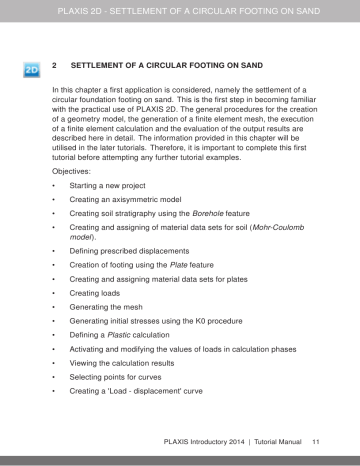

The grid can deform in small and large-strain mode and move with the material that is represented. The two programmes simulate the behaviour of soils, structures built on soil, rock, or other materials that may have undergone plastic flow when their yield limits are reached. FLAC Version 3.3 is a two-dimensional explicit finite difference program. Higher-order 15-noded or 6-noded elements are used to model the geometry. All models can deal with drained/undrained and nonporous material behaviour.
#MODEL STEEL MATERIAL PLAXIS 2D CODE#
Plaxis 2D is a finite element code for 2D plane strain and axisymmetric modelling of soil and rock behaviour for use on fast personal computers. The results of the numerical analysis ware benchmarked against similar analysis reported by Han and Gabr who used FLAC (Fast Lagrangian Analysis of Continua) in an FDM analysis. In this study Plaxis 2D v9.0 was utilized to model the GRPE problem using an FEM approach. There are numerous types of numerical methods of simulating a geosynthetic reinforced piled embankments two of the most common modes of analysis are Finite Element Method (FEM) and the Finite Difference Method (FDM). Design procedures based on limit equilibrium methods neglect any aspect of soil and reinforcement deformability consequently the design approach is not fully satisfactory if the objective is to investigate the time-dependent performance of the structure.Īpplication of sophisticated numerical modelling techniques improves both the reliability and the economy of engineering design. Numerical techniques have become more common place in the simulation of the structural performance due to improved computing power and more complex soil/material models. A number of design methodologies have been proposed for GRPE's BS 8006 : 1995, EBGEO, Carlsson, Hewlett and Randolph, Russell et al. In both design and analysis of geosynthetic reinforced piled embankments analytical and numerical techniques are utilized. The design of reinforced piled embankments is a complex soil-structure interaction problem involving embankment fill, geosynthetic reinforcement, a pile group, and the soft underlying soil see Love and Milligan. Typical geosynthetic reinforced piled embankment. Rowe and Li, Bergado and Teerawattanasuk Briançon and Villard Li and Rowe Rowe and Taechakumthorn Abusharar et al. The inclusion of geosynthetic reinforcement just above the pile caps enhances the load transfer efficiency, minimizes yielding of the soil, and reduces total and differential settlements, Han and Gabr Russell and Pierpoint Varuso et al. Pile/column supported embankments improve structural stability and reduce embankment deformations. Han and Gabr suggested the benefits associated with reinforced piled embankments are (1) single stage construction without prolonged waiting times (2) significantly reduced differential settlements (3) reduced earth pressures (4) to avoid excavation and refill employed. The geosynthetic-reinforced piled embankment (GRPE) structure consists of closely spaced piles which penetrate the soft soil to reach a stiff bearing substratum, the pile group is overlain by the geosynthetic reinforced, upon which the embankment is constructed, Figure 1. Geosynthetic reinforced piled embankments are widely used to overcome these problems when constructing on soft soil. Design of embankments on soft ground raises several concerns such as bearing capacity failure, differential settlements, lateral stresses, and structural instability.


Special construction methods are required when embankments are constructed on very soft clay or peat. However the FDM approach was found to give a slightly higher reinforcement tension and stress concentration but lower reinforcement strain at the pile cap than FEM, which was attributed to the greater discretize of the model geometry in the FDM than in FEM. FEM consistently replicated the FDM outputs for deformational, loading, and load transfer mechanism (soil arching) response within the reinforced piled embankment structure with a reasonable degree of accuracy. The FEM and FED techniques were found to be in reasonable agreement, in both characteristic trend and absolute value. Plaxis 2D (FEM) was utilized to replicate FLAC (FDM) analysis originally presented by Han and Gabr on a unit cell axisymmetric model within a geosynthetic reinforced piled embankment (GRPE). The numerical modelling of geosynthetic-reinforced piled embankments using both the finite element method (FEM) and finite difference method (FDM) are compared.


 0 kommentar(er)
0 kommentar(er)
